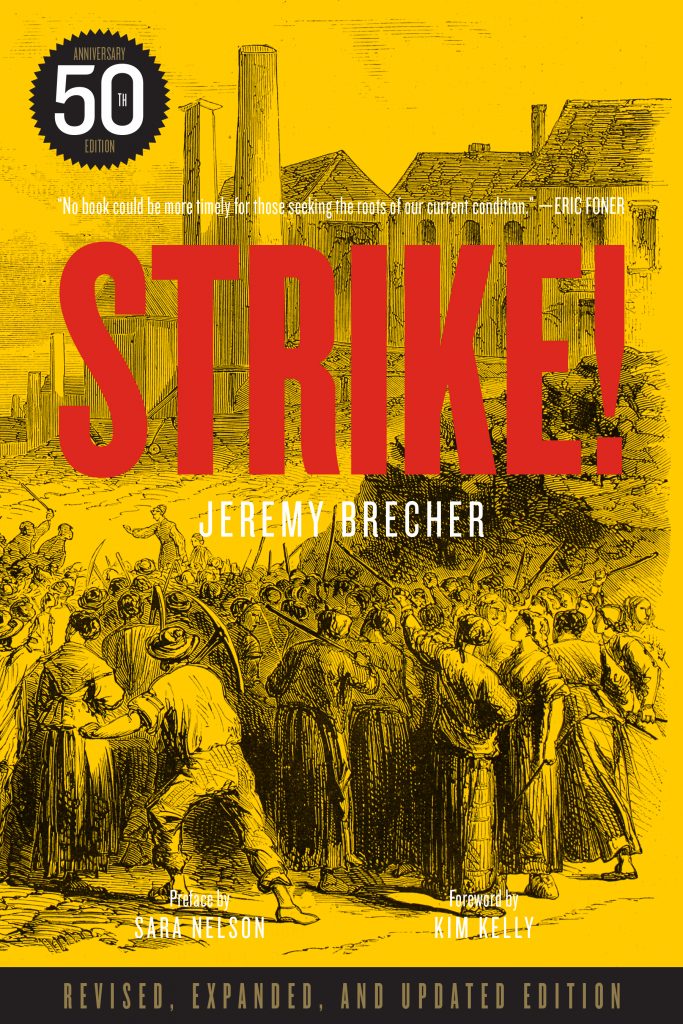With its aggressive use of the military at home and abroad, the Trump administration appears to be on the offensive. But its aggressions are less an expression of growing power than an attempt to distract from the growth of opposition, the loss of public support, and the splits within its own ranks. The movement-based opposition, represented by the mass nonviolent resistance to ICE in Los Angeles and the five million participants in No Kings Day, is no longer a marginal actor but is now MAGA’s most powerful opponent. How can it utilize that power?

California National Guard in front of protestors. Photo credit: U.S. Northern Command, Wikipedia Commons, Public Domain.
In a Strike! Commentary posted May 21, 2025 I wrote, it is “likely” that Trump “in the face of declining power and support” will “increasingly utilize repression and violence.”
Internally this would mean a fuller suspension of civil liberties and the rule of law; a more brutal war on dissent; martial law; use of the military in domestic conflict; and a mobilization of violent MAGA supporters for direct vigilante action. Internationally it would mean escalating use of violence, leading to accidental or deliberate wars – not excluding accidental or intentional nuclear escalation.
I cite this, not to claim prophetic powers that allowed me to predict Marines in Los Angeles and bunker busters in Iran, but because this dynamic is shaping the context for the movement to defend society against the MAGA assault. The growing power of Trump’s opponents, and his escalation in response, creates new strategic problems and opportunities for the movement. This requires an assessment of the current state of the conflict in preparation for its next phase.
In a drama or a war, there is a critical point where protagonist and antagonist meet and the battle has been joined. That point has arrived as MAGA and those defending society against MAGA have now come into direct conflict in the public arena. This can be seen in the confrontation in Los Angeles between the ICE agents dressed and acting like storm troopers and the nonviolently resisting workers and communities. And it can be seen in the contrast so often drawn between Trump’s pathetic military birthday parade and the historic No Kings Day actions by at least five million people at more than two thousand locations around the country. As the New York Times lead headline encapsulated it June 15, “Military Might, Protest Power: Two Visions of U.S. Take to the Streets.”
The movement-based opposition, so visible in resistance to ICE in Los Angeles and in the outpouring of millions around the country, is no longer operating in its own isolated niche, seemingly without direct engagement with its opponents. Donald Trump would like this to be seen as a battle of his forces against the immensely unpopular Democratic Party. (A Quinnipiac University poll conducted in early June found that seventy percent of those asked said they disapprove of how Democrats are handling their jobs in Congress, while only 21 percent approve.) At this point the opposition to Trump is far less the Democratic Party than the vast popular movement that is opposing his actions and undermining his power.
Beyond the movement represented in the streets there is an even wider swath of people and institutions, from medical and legal associations to teachers and government employees, defending society against the MAGA assault. The Times’ “Two Visions” represents an acknowledgement that the pivotal battle for the future of the United States is now between MAGA and the movement to defend society against it.
Trump’s crumbling juggernaut

Trump appears to be on the offensive, as illustrated by his ordering federalized National Guards and Marines into Los Angeles and sending US bombers to attack Iran. But it’s a well-known maxim that when politicians or countries are losing, they tend to escalate. As Senator Alex Padilla put it after he was handcuffed, thrown to the ground, and arrested by ICE agents,
When Mr. Trump began to face a groundswell of criticism a few weeks ago for his unpopular Medicaid cuts, failed tariff wars and embarrassing public breakup with a billionaire adviser, I suspected that it wouldn’t be long before he broke out the same tired anti-immigrant tactics to distract the public. Raids intensified, detentions skyrocketed, and Mr. Trump’s narrative of crisis escalated in the hopes of diverting attention from his political failures.
The same desire to divert attention from his failures no doubt provided a similar motivation for launching his illegal war against Iran.
Trump’s escalations are largely a response to his failures, contradictions, loss of public support, and fracturing base. At the end of his first 100 days, Donald Trump had the lowest 100-day job approval rating of any president in the past 80 years. In a Reuters/Ipsos poll published June 23, Trump’s approval rating had fallen to 42%; his disapproval rate had grown to 57%.
Even more significant are the splits in his coalition and the growth of public opposition to his major initiatives. Trump’s claims to be a “peacemaker” who will rapidly end all current wars have been severely eroded by the failure of his promises to end the wars in Ukraine and Gaza and now his joining Israel’s war against Iran. His flirting with war against Iran put MAGA leaders at each other’s throats and undermined his support in the general public and even among the MAGA base, with MAGA pundits like Steve Bannon and Tucker Carlson trading insults with Ted Cruz. Immediately after the bombing, the Proud Boys posted a message simply saying, “Fuck this shit.”
As polling on Trump’s bombing of Iran comes in, it is clear that the public opposes it – and war with Iran more broadly. For example, a CNN poll in the days following the bombing found that Americans disapprove of the strikes, 56% to 44%. 68% of those under 35 disapproved. 55% of Americans express little or no trust in Trump to make the right decisions about the US use of force in Iran. 65% of those polled say Trump should be required to get congressional approval for any further military action, with only 21% saying he should not.
Trump’s militarized ICE raids in Los Angeles and around the country, instead of rallying people against the immigrant menace, have led to a growing disillusion not only with its specific abuses, but with his immigration policy as a whole – once his most popular position.
On June 20, CNN senior data correspondent Harry Enten analyzed poll data since Trump sent troops into Los Angeles.
Donald Trump has lost the political battle when it comes to what has happened out in Los Angeles! Donald Trump’s net approval rating on the Los Angeles process — look at this! Overall, way, way, way underwater at minus 15 points.
Among independents or those who don’t identify with either major party, minus 24 points on the net approval rating. This is happening on what should be the best issue for Donald Trump, immigration. And yet when it comes to these Los Angeles protests, 15 points underwater overall and 24 points underwater among independents. No good.
If the protesters’ idea was to focus the attention on Donald Trump and bring attention to his immigration policies and bring attention to the arrests that have been occurring of immigrants, it seems to me that those protests have been successful because 49% say Trump’s gone too far when it comes to the immigrant arrests compared to just 40% who say he’s not gone too far.
More ICE raids at workplaces. Workplaces where immigrants perhaps are here illegally. Look, 45% approve. But again, what’s the winner here? 54% disapprove of the idea of more ICE arrests. And this, again, goes to what these protests were all about in the first place. These ICE arrests at work. And it does seem, again, that the American people are with the protesters on this.
On inflation – a prime concern of those who voted for Trump in 2024 — 64% of the public now disapproves of him compared to 34% who approve.
The tariffs Trump touted as the solution to US economic problems have met deep concern from corporate America – a critical part of his base—as well as from the public at large.
Consumer sentiment has gone down for four straight months since Trump’s “Liberation Day” when his tariffs were first announced. It has now reached the lowest level ever recorded except during the post-COVID inflation. The tariffs are also splitting the MAGA coalition; for example, Leonard Leo, architect and longtime leader of the Federalist Society, has sued to block Trump’s claim to the authority to set tariffs without Congressional approval.
Trump’s “big beautiful” budget bill is now extremely unpopular. A Fox News poll found registered voters oppose it 59% to 38%, including 53% to 43% opposition among white men without a college degree, usually portrayed as Trump’s strongest demographic. In a poll by The Washington Post and Ipsos, 23% of adults support “the budget bill changing tax, spending and Medicaid policies,” while 42% oppose it. In an NBC News Decision Desk poll, 51% of Americans said “maintaining current spending levels on programs like Medicaid” mattered most to them, compared to 21% who chose “continuing and expanding income tax cuts and credits” enacted by Trump in 2017, and 28% who chose “ensuring that the national debt is reduced.”
Finally, what about Trump’s assault on constitutional government and the rule of law? The most extensive polling on this came at the end of his first 100 days, when 56% said Trump had acted beyond his authority as president without justification and 55% doubted the Trump administration’s commitment to protecting citizens’ rights and freedoms. People said by a margin of 67%-31% that they thought the Trump administration was trying to avoid complying with court orders regarding its activities rather than trying to comply with those orders. And by 67%-31% they said federal judges should have the authority to block an administration policy until a trial if they think it will harm people and is probably illegal.
Storm-trooper-style action by ICE and bombing Iran without Congressional authorization may well have deepened public concern about Trump’s move to authoritarian rule.
Breaking the chain

Protest in Kiener Plaza, St. Louis, Missouri, Photo credit: Chris Yunker , Wikipedia Commons, CC by 2,0
American society has made an unexpectedly powerful start at defending itself against the MAGA assault. Social Self-Defense is ranging from days of action with millions of participants in thousands of locations to mass nonviolent obstruction of ICE kidnappings to mobilizing mass pressure to defeat MAGA legislation.
A chain will break at its weakest link. We don’t yet know what MAGA’s weakest link is, but we can increasingly identify weak links where the movement-based opposition can achieve good results by increasing the pressure it is already applying. Here is a partial “to do” list:
- Continue to highlight and contest Trump’s abuses of democracy, the rule of law, human and civil rights, and the Constitution. Continue to combine a focus on the destruction of democracy and the rule of law with the concrete human needs that are being destroyed by the MAGA assault.
- Encourage the popular opposition to the bombing of Iran, a future war with Iran, and future militarist adventures. For example, build it in as a central part of the messaging for upcoming days of action. Portray it for what it is: Yet one more “executive usurpation” of the constitutional limits on executive power.
- Make the fight against ICE what Birmingham was for the civil rights movement and what the Keystone XL pipeline was for the climate movement: a dramatic, highly visible struggle between those in power and those opposing them. Highlight the abuses that are most abhorrent to the public, like the kidnapping of workers, the separation of families, deportations without due process, arrests of legal citizens, and arbitrary arrest of immigrants with no criminal records. Demand an end to all ICE arrests without due process of law.
- Make an issue of every MAGA effort to attack their opponents with slander and violence. Insist on justice and restitution for those harmed by MAGA attacks. Demand exposure and prosecution of armed vigilante conspiracies.
- Expand the mass days of action that manifest growing disaffection from MAGA and the growing reach of the movement-based opposition. Use them to build and reinforce local organizing.
- Support and encourage the development of self-organization and protest among the huge constituencies Trump is harming like current and future Medicaid and Social Security recipients. A great example is the joint campaign by MoveOn, Working Families Power, Indivisible, Community Change Action, Public Citizen, and others to reach out to millions of Medicaid recipients to tell their Senators to oppose MAGA’s “big beautiful” budget bill.
- Continue and expand the emphasis on MAGA policies as a product of billionaire control of government and the need to restore democracy as a means to make government serve the needs of working people and the poor.
- Use the tactics of the “Tesla Takedown” that drove Elon Musk out of Washington to excoriate and disempower the billionaires, especially the tech billionaires, who are such key “pillars of support” for the Trump administration and MAGA Republicans.
- Build “strange bedfellow” alliances with the institutional resistance represented by such groups as the American Medical Association and the American Bar Association.
No one of these is likely to provide a knockout blow. But each of them will help erode Trump’s power and support. By immobilizing his regime they can reduce the harm he is able to do. They can lay the groundwork for defeating MAGA Republicans in upcoming elections. And they can sow the seeds for mass social strikes that, if necessary, can mobilize the entire power of society to defeat and eliminate MAGA’s authoritarian rule.









